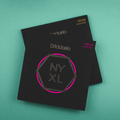PETER GREEN
By Strings Direct – 29 August, 2023
PLAYER SPOTLIGHT
“If you’re comfortable in life, I think the blues might evade you. Suffering is something holy.”
Guitarplayer.com (2003)

As we progress through so many players with various styles we discover you can never fully predict or stereotype any musician by their style in conjunction with their string choice.
This journey of discovery has demonstrated the incredible contrasts in players' choices and ongoing curiosities & inspirations that keep them forever experimenting with their equipment and strings.
A reoccurring factor that always presents itself would be the power of the individual touch, as much as the equipment and string choice is essential to a player's individual tone, their individual touch and technique is another large part of the overall tone.

This singular statement could not be more true for this week's case study...
One of the most idolised guitar players that has ever lived, and many great guitar players' favourite player. A truly humble player that was never aware of the monumental impact he made. An English guitarist that poured his every emotion into every note, which is what he became so well-known for and why he was so well loved.
As a musician he was poetic and as a guitar player he was just a sonic revolution of human emotion.
We can only be talking about the eternal legend known as Peter Green. 🎸
Man of The World 🌎
We begin in Bethnal Green, London where Peter Allen Greenbaum was born 29th October 1946 into a jewish family. Parents Joe and Anne cherish young Peter as he was the youngest of four children, Peter grew up in a traditional Jewish surrounding.
As his family were fairly traditional and somewhat reserved there wasn't a massive musical presence and influence within the family home.
Peter began to show an interest in music through his older brother Len. Curiosities lead him to learn his first few basic chords with his brother Len and from there the fire 🔥 was lit.

Peter progressed with the guitar and became more embedded into the spiritual side of the instrument music, quickly became a staple within the Greenbaum household.
“Peter, what was the first music you heard as a boy that really inspired you?
My brother used to bring home these skiffle records. One that we really liked was “Freight Train” by Chas [McDevitt] and Nancy Whiskey, but Lonnie Donegal was the real king of skiffle. I loved the way he played his guitar and thought I should have a go at it. My brother gave me a guitar, an old Spanish hand-me-down. I didn’t know any chords. I was just strumming the thing open.
I didn’t even know how to tune the guitar properly. I would just tune it in some way that appealed to my ear. Just made up my own chords. I played the strum over with my right hand, and with my left hand would just hold the neck someway comfortably, but I wouldn’t put my finger on the fretboard yet. I first learned how to strum, or “jang,” as I used to call it.
P. Green - Guitarplayer.com
Music for Peter became an instant form of escapism as he was working a job as a young man as a butchers assistant in Putney.
“He taught me a bit, but I was never any good at chords,” Green remarks. “I always preferred to play the tune. I used to like Hank Marvin’s finer work, and my brother Michael and I learnt to play Apache – but he’d play the chords while I always picked out the tune.”
Peter Green - guitar.com
As we all know early inspiration is everything in regards to motivation and playing and progressing on an instrument. Like many musicians back then there was a fundamental influence, one that is continually shared across many generations but for this generation in particular it had a monumental impact.
“You’ve cited Hank Marvin of the Shadows as a big early guitar hero of yours. What was it that most appealed to you about his guitar playing?
That slinky sound. He had this gorgeous Fiesta Red Stratocaster, and he would get this very special Stratocaster sound from it. What I especially liked was the way he was very gentle with the tremolo arm. It was the coming of the use of the tremolo arm.”
Peter Green on Hank Marvin - guitarplayer.com

During this time period was an experimental time for young and budding musicians. Once Peter had started playing he quite quickly progressed and was out on the scene playing with a few local bands and musicians.
“At the time Peter owned a Harmony Meteor semi-acoustic that had been given to him by the guitarist in one of his early bands. “It was a beautiful guitar,” he remembers fondly. At one point he’d actually converted the Harmony into a four-string bass, but inspired by Clapton’s playing he once again replaced the nut and bridge to return the guitar to six-string form. Clapton was only 18 months older than Green, but musically and professionally was already on another level. Legend has it that Peter would regularly grab the obliging Eric Clapton after Yardbirds gigs and absorb some playing tips.”
P. Green - guitar.com

Peter Green’s Fleetwood Mac 🥁
Playing the circuit and being on the scene is essential for any musician and back then during the 1960s it was the key way to meet your heroes and claim your position as an up-and-coming musician.
London in the swinging 60s was a close-knit community but also quite an open community in regards to music and art.
Night after night you could go and see someone who was very much in the public eye, such as Eric Clapton, and literally get up close and personal, this very much how Peter Green learnt from his idols and mentors.
The story famously goes that Peter Green was persistent with John Mayall and kept being quite inquisitive, to the point of almost asking to be in the group or have the opportunity.
“I still didn’t ever make any conscious decision to play blues guitar, but I’d seen Eric Clapton playing with John Mayall so much,” Green recalls. “Peter B’s Looners used to support John Mayall at the Flamingo club, and when I found out Eric was going to Greece [in the summer of 1965, when Clapton left the Bluesbreakers to perform in Greece with a band called The Glands – Ed], I went along to the Zodiac Club in Putney where I lived to try and get an audition. They had someone called Jeff Kribbetts playing guitar, and although I didn’t necessarily think that I could do a better job than him, I just wanted to have a go! He was doing these little blues phrases like the riff on My Babe, and I thought, ‘I can’t do that’ – but I also noticed that he had big fingers, and that encouraged me.’
Green eventually buttonholed John Mayall during the interval of a Bluesbreakers gig in August 1965. Mayall remembers it well: “Peter got up from the audience and came up to me angling for the job saying ‘Let me play. I’m better than he is,’” he laughs.”
P. Green - guitar.com
Through a process of events and by chance and pure persistence, Peter eventually joined John Mayall's Bluesbreakers group.
With so much admiration for Eric Clapton as one of his idols he took the opportunity seriously and invested in a new instrument and set up; at the time it seem like a standard thing to do but as history tells us this was one of the most iconic moves by any guitarist ever, this would go on to become one of the most desirable instruments in the history of music.
Determined to match Clapton’s sound, Green bought a sunburst 1959 Gibson Les Paul and a 50-watt Marshall amplifier with a single 4×12″ cabinet. His return to the band brought an immediate change in the Bluesbreakers sound: ‘The first time I used that guitar was when we playing Klooks Kleek, and John said, ‘So that’s your new weapon! You should do better with that,’ Peter laughs.
P. Green - guitar.com
One year into his tenure with the John Mayall group Peter actually left even though relationships in, and around the band were reportedly good, it is still unclear and unknown as to why Peter made the move. But this move fundamentally led Peter into his next and greatest project.
Somehow through the remnants of the Bluesbreakers project Peter Green’s Fleetwood Mac was formed. Some stellar personalities and some of the big musicians came together at this time and really produced some incredible material.
Peter Green's incarnation of the Fleetwood Mac would go on to produce some of the most iconic musical masterpieces of our time.
To this day some of this material is unmatchable in terms of the riff written/structure and of course the pure emotion.
Expressive creativity and miraculous poetic song craft, we are of course all familiar with the ever fascinating Albatross.
The 1959 Burst - “Greenie” … 🎸
As we expect every guitar hero has an associated iconic and instantly recognisable instrument. The story of Peter Green's 1959 Gibson Les Paul Standard is one of myth and legend and is ongoing to this day.
The story of the instrument and how it is passed across to various custodians over the years is absolutely magical.
One of the best in rock 'n' roll history I believe that guitar has built up such intrigue fascination and desirability it is now one of the most expensive guitars in the world, and definitely one of the most sought after.

The guitar now resides with Metallica’s Kirk Hammett and there is much mystery that surrounds how much he paid for it and how he came to wield it.
It is the guitar of destiny and the spiritual voice box of the late great to Peter Green, it also has the spiritual projection of the late great Gary Moore.
The guitar has had many traumas brakes changes and general hardware throughout its life; the story can be told in words but there is an amazing video by a good friend of mine Phil Harris.
This video not only tells you the story of the guitar but the history, technical changes the damage and also demonstrates the guitar’s incredible sonic beauty!
One of the key features of this guitar is of course the out of phase pickup in the neck position which creates that Fender-style gingle coil tone which has now become signature to Peter Green’s impeccable sound palette.
Blues Wires For Green’s Fingers 🎼
The one thing that many guitar players and musicians adore about Peter Green’s guitar playing is the pure emotion he can convey through the strings into the sound and what he can project out of the instrument.
Peter is one of these players that as soon as you hear him you just know it's him; his identity is all over the sound and his feel is instantly recognisable.
So the mystery would be what type of strings does a master magician use to create such subtle vibrato and wide emotion?
As with many traditional players from a certain generation they are quite quiet about the strings they use and the specification they use, or maybe they're just quite relaxed about it and don't think about it too much and leave it to somebody else to just string the instrument... who knows? 🤷♂️
But we do have is this one quote from Peter himself during interview:
“And for guitar strings, nine or 10 gauge?
I would never touch a nine or a 10. I actually prefer 11s or 12s, and at one time used 13s. Especially for slide, I prefer really heavy strings. And I also prefer playing without a pick, because I don’t want to have to think about it.”
Peter Green - guitarpalyer.com
This quote gives us a good idea and let’s us know that throughout his career Peter did go for a bigger string for a thicker tone and a more dynamic feel.
This, of course, leaves things very open-ended so we can only estimate what he would use or what he did use, for this we will refer to our fellow guest blogger here at Strings Direct the Happy BluesMan, he has a great piece here that encapsulates the spirit of Peter Green’s tone and string choice:
“Happy BluesMan - Strings
Unlike many of the players that I have covered in my ‘Sound Like Series‘ so far, guitarists have placed much less focus on the strings that Peter Green used. There is speculation that Green used quite heavy gauge strings – possibly as heavy as .012. There is also some speculation that he raised his pickup height much higher than other players, which allowed him to play thinner strings, but make them sound like they were heavier. However there doesn’t seem to be any concrete evidence of either of these theories.
So when it comes to choosing strings, I would focus on using the gauge that allows you to play at your best. Given that Green doesn’t play fast, but does favour big soaring bends and long sustaining notes – it might be worth opting for a slightly heavier gauge of string. But I wouldn’t worry about it too much. Some different brands and gauges I would recommend are as follows:
DR Pure Blues (.010-.046)
Ernie Ball Classic Rock N’ Roll (.010-.046)
Experiment with a few different brands and gauges until you find what works best for you.”
* * * * *
REFERENCES
https://www.bbc.co.uk/news/uk-53539989
https://www.guitarplayer.com/players/peter-green-talks-life-music-demons-and-gear-in-this-previously-unpublished-2003-interview
https://guitar.com/features/interviews/peter-green-on-guitar-fleetwood-mac-the-yardbirds-and-more/
https://en.wikipedia.org/wiki/Peter_Green_(musician)
https://www.rollingstone.com/feature/peter-green-fleetwood-mac-guitar-hero-1034049/
https://www.abalonevintage.com/1959_gibson_les_paul_standard_guitar_kirk_hammett_metallica_peter_green_gary_moore_greeny_owner.htm
https://happybluesman.com/
https://www.discogs.com/artist/76045-Peter-Green-2





